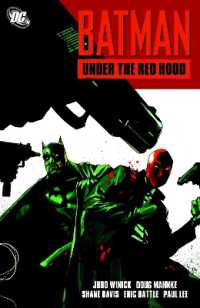- ホーム
- > 洋書
- > 英文書
- > Psychology
Full Description
Negative Empathy in Literature and the Arts explores how readers and viewers engage cognitively and affectively with ethically troubling artworks across literature, the visual and performing arts, and screen media. Drawing on aesthetics, cultural history and theory, psychology, and neuroscience, Stefano Ercolino and Massimo Fusillo introduce the concept of "negative empathy" to describe the ambivalent and destabilizing emotional responses elicited by representations of negativity in art. Rather than dismissing empathy as naïve, the authors argue for a more nuanced understanding of its darker forms and their cognitive and ethical value. Through a comparative and intermedial approach, the book analyzes case studies from Littell's The Kindly Ones to Wilson's Deafman Glance; from Verdi's Macbeth and Nitsch's Theatre of Orgies and Mysteries to Caravaggio's Martyrdom of Saint Matthew, Mapplethorpe's "X" Portfolio, Kiefer's The Seven Heavenly Palaces, Haneke's The White Ribbon, and Gilligan's Breaking Bad—offering a compelling new theory of aesthetic engagement.
Contents
List of Figures
Why Negative Empathy?
Chapter One. History and Theory of an Idea
1. Resonance and Distance
2. Empathetic Suffering
3. Identification, Catharsis, Stimmung
Chapter Two. Seductions of Rhetoric
1. Inner Torment, Psychological Complexity, Eloquence
2. Brothers in the Night: Jonathan Littell's The Kindly Ones
Chapter Three. In the Rhythm of the Scene
1. Tragic Lacerations
1.1 Empathy and Estrangement
1.2 Medea's Theatricality
1.3 Repeating the Abnormal Act: Robert Wilson's Deafman Glance
2. The Force of the Voice
2.1 The Dramaturgy of the Antagonist in Melodrama
2.2 A Broken and Expressionist Song: Giuseppe Verdi's Macbeth
3. Beyond Representation
3.1 Shadowy Actions
3.2 The Ecstasy of Ritual Dismemberment: Hermann Nitsch's Theater of Orgies and Mysteries
Chapter Four. Nostalgia and Anguish for Life
1. The Power of Images, the Power of Empathy
2. Stimmungseinfühlung
3. Abstraction vs. Empathy
4. Embodied Vision: Caravaggio's Martyrdom of St. Matthew
Chapter Five. The Multiplied Gaze
1. On Medusa's Side
1.1 The Frozen Moment
1.2 Power Games
1.3 Aestheticizing the Extreme: Robert Mapplethorpe's "X" Portfolio
2. Labyrinths of Perception
2.1 Immersive Environments
2.2 Among the Ruins of History: Anselm Kiefer's Seven Heavenly Palaces
Chapter Six. Audiovisual Simulations
1. In the Darkness of Their Eyes
1.1 Identifying with Bad People
1.2 Empathizing with a Community: Michael Haneke's The White Ribbon
2. Serial Pleasures
2.1 TV Antiheroes
2.2 Challenging Empathy: Vince Gilligan's Breaking Bad
Bibliography
Index






